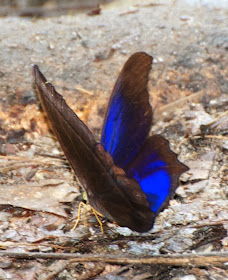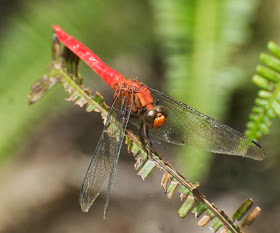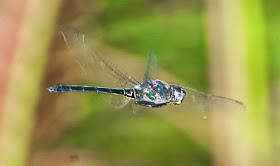The next day - February 24, 2003 - Chips, Shirley, Annie, Eileen and I set out for a more substantial hike, along the trail to the waterfalls at Sungai Chiling in the foothills below Fraser's Hill.
We set out together, crossing a boardwalk over the river and into the forest - but as before I quickly fell behind, distracted by insects, flowers and other things. Finally - at a particularly steep declivity on the trail, I decided that it would be better to let the others press on to the falls while I worked my way - slowly - back along the river edge, seeing what I could see.
There was, in fact, a lot to keep me happy.
Even if there isn't much to see in the way of wildlife, the myriad shapes of the leaves in a tropical forest are fascinating in themselves.
Some are even more fantastically-shaped once the insects get through with them.
There are flowers, too; this orchid is, I think, Bromhedia finlaysoniana, a common weedy species.
Here, in a bit of botanical serendipity, it blooms next to a pitcher plant (Nepenthes gracilis).
Clumps of Nepenthes gracilis were, in fact, frequent along the edge of the trail.
The pitchers on this species must be among the smallest in the family.
Malaysia has a rich flora of spectacular gingers. As far as I can tell, these are both Alpinia rafflesiana.
Here, a spectacular ginger is being visited by a spectacularly long-tongued bee – apparently bees such as these are frequent pollinators of ginger flowers.
Insects, in fact, provided the wildlife highlights of the day. We had arrived at our destination a bit too late for most of the forest birds to be active. Insects, however, there were plenty, including this impressively goggle-eyed fly.
Also, I presume, interested in flies: a Giant Orb-weaving Spider (Nephila pilipes).
This sombre-looking butterfly is Coelites epiminthia epiminthia, an apparently uncommon denizen of the forest floor. It doesn't appear to have an English name.
It's not as plain as it looks from below – when it opens its wings, it reveals rich, deep cobalt iridescence on its upper surface.
The Common Three-Ring (Ypthima pandocus corticaria), an abundant trailside butterfly, is equally plain – or, at least, non-iridescent – both above and below.
The same can be said for Orsotriaenia medus cinerea, whose common name I have forsworn mentioning here.
I usually find Commanders (Moduza procris milonia) perched on rocks, but this one is making do with a bit of wet muddy gravel. No doubt it spends time on the rocks in the river bed when it gets a chance.
No bright colours, but graceful and attractive nonetheless: the Common Imperial (Cheritra freja), one of a group of Asian hairstreaks with long, lacy tails on their hindwings - distractions, one assumes, for hungry birds.
I am definitely not an expert on skippers. Which one is this? [Thanks to Bluebottle: it's a Bush Hopper (Ampittia dioscorides)]
This butterfly should be easy, but I'm a bit puzzled by it. I believe it is a Common Mime (Papilio clytia), one of a group of swallowtails that mimic distasteful butterflies in the Danaiinae.
The problem is that though it appears to be one of the dark forms of this species (P. c. clytia), but does not appear to have the yellow spots at the bottom of the upper hindwing that clytia should have. Is my identification correct? Or has another mimic taken me in? [indeed it has: Bluebottle tells me that this is probably another mimic swallowtail, Pendlebury's Zebra (Graphium ramaceus)]
As I worked my way back down the trail I made occasional detours out onto the rocky river bed to check for damselflies.
Schools of young Malayan Mahseer (probably Tor tambroides), locally known as kelah - the raison d'être of the reserve, which was gazetted as a fish sanctuary - patrolled calmer pools among the stones.
My damselfly hunt yielded what I think is one of the prettiest of the lot, Euphaea ochracea. The bright yellow stripes on the thorax and ochre-tinted wings mark this as a young male; female wings are clear, and the stripes darken to orange-red with age.
Back along the trail I found a few Vestalis damselflies, presumably Vestalis amoena, perching (as is their wont) on the tips of leaves in the understory.
This cadaverous-looking individual is a young, or teneral, or "ghost phase" female.
Back along the trail, I was entertained by a number of common dragonflies. This is a Neurothemis, N. ramburii I think.
Orthetrum dragonflies come in a number of colours. If you prefer red, you can choose between O. chrysis...
…and the even redder O. testaceum.
If you'd prefer something in a nice pruinose blue, your normal choice would be O. glaucum.
However, this time I came across another choice, with paler blue eyes and thorax: O. luzonicum, a common species, but that I had never identified for certain before.
All of the foregoing dragonflies one might find anywhere in edge situations or open country - insects I tend to call "ditch dragonflies". This one, though, was something special (at least for me).
It was Zygonyx iris, a rushing-stream specialist with a preference for waterfalls. This is an adult male (the females and young males are marked with yellow. Besides being new to me and highly iridescent, it had the habit of hovering in one spot long enough so that even I could photograph it in flight (a good thing, because apparently they don't perch very often).
I am not sure why this male is hovering with the tip of the abdomen curved down (other than to show off his claspers), though he may be simply getting ready to latch on to a female should one happen by.
So, all in all, I had a good time - and, by the way, the others did get to the waterfall without me!






















+DSC_6464.jpg)

+DSC_6633.jpg)
+DSC_6624.jpg)

+DSC_6484.jpg)
+DSC_6488.jpg)
+DSC_6492.jpg)

+DSC_6601.jpg)















Love the damselflies and dragonflies, so ethereal! If you crush the Bromhedia finlaysoniana leaves, you will get a hint of fragrant screwpine (pandan) scent. They are lovely and the plant can grow taller than 6 feet.
ReplyDeleteI'll have to try that next time!
ReplyDeleteThat's a nice collection of butterflies you have there!
ReplyDeleteThe skipper should be an Ampittia dioscorides (The Bush Hopper). It is actually one of the more distinctive skippers!
The mime - ish thing is a little less straightfoward. It is actually a Graphium!! (bluebottles.. jays..) I think that it should be the Graphium ramaceus (The Pendlebury's Zebra). It does get confusing because some butterflies for Müllerian rings, where they all mimic each other.
The Nepethes are great too. I can't believe that pitcher is so small!
Thanks again - I've added your corrections.
Delete